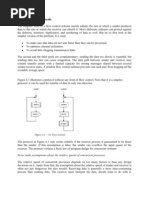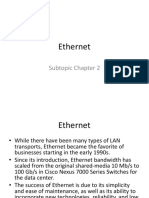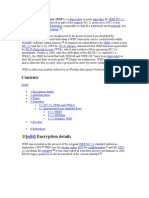TCP and Its Algorithms (Slow-Start, Congestion Avoidance, Fast Retransmit and Fast Recovery)
TCP and Its Algorithms (Slow-Start, Congestion Avoidance, Fast Retransmit and Fast Recovery)
Uploaded by
Afzal BhattiCopyright:
Available Formats
TCP and Its Algorithms (Slow-Start, Congestion Avoidance, Fast Retransmit and Fast Recovery)
TCP and Its Algorithms (Slow-Start, Congestion Avoidance, Fast Retransmit and Fast Recovery)
Uploaded by
Afzal BhattiOriginal Title
Copyright
Available Formats
Share this document
Did you find this document useful?
Is this content inappropriate?
Copyright:
Available Formats
TCP and Its Algorithms (Slow-Start, Congestion Avoidance, Fast Retransmit and Fast Recovery)
TCP and Its Algorithms (Slow-Start, Congestion Avoidance, Fast Retransmit and Fast Recovery)
Uploaded by
Afzal BhattiCopyright:
Available Formats
1.
TCP and its Algorithms (Slow-Start, Congestion Avoidance, Fast Retransmit and Fast Recovery) TCP is a complex transport layer protocol containing four interwined algorithms: Slowstart, congestion avoidance, fast retransmit and fast recovery. In Slow-start phase, TCP increases the congestion window each time an acknowledgement is received, by number of packets acknowledged. This strategy effectively doubles the TCP congestion window for every round trip time (RTT). When the congestion window exceeds a threshold named ssthresh, it enters congestion avoidance phase. TCP congestion window is increased by 1 for each RTT until a loss event occurs. TCP maintains a timer after sending out a packet, if no acknowledgement is received after the timer is expired, the packet is considered as lost. However, this might take too long for TCP to realize a packet is lost and take action. A fast retransmit algorithm is proposed to make use of duplicate ACKs to detect packet loss. In fast retransmit, when an acknowledgement packet with the same sequence number is received a specified number of times (normally set to 3), TCP sender is reasonably confident that the TCP packet is lost and will retransmit the packet. Fast recovery is closely related to fast retransmit. When a loss event is detected by TCP sender, a fast retransmit is performed. If fast recovery is used, TCP sender will not enter slow-start phase, instead it will reduce the congestion window by half, and inflates the congestion window by calculating usable window using min(awin, cwnd+ndup), where awin is the receivers window, cwnd is the congestion window, and ndup is number of dup ACK received. When an acknowledgement of new data (called recovery ACK) is received, it returns to congestion avoidance phase.
2. Tahoe, Reno, NewReno, and SACK TCP Tahoe is the simplest one out of the four variants. It doesnt have fast recovery. At congestion avoidance phase, it treats the triple duplicate ACKs same as timeout. When timeout or triple duplicate ACKs is received, it will perform fast retransmit, reduce congestion window to 1, and enters slow-start phase. TCP Reno differs from TCP Tahoe at congestion avoidance. When triple duplicate ACKs are received, it will halve the congestion window, perform a fast retransmit, and enters fast recovery. If a timeout event occurs, it will enter slow-start, same as TCP Tahoe. TCP Reno is effective to recover from a single packet loss, but it still suffers from performance problems when multiple packets are dropped from a window of data. TCP NewReno tries to improve the TCP Renos performance when a burst of packets are lost by modifying the fast recovery algorithm. In TCP NewReno, a new data ACK is not enough to take TCP out of fast recovery to congestion avoidance. Instead it requires all the packets outstanding at the start of the fast recovery period are acknowledged. TCP NewReno works by assuming that the packet that immediately follows the partial ACK received at fast recovery is lost, and retransmit the packet. However, this might not be true and it affects the performance of TCP. SACK TCP adds a number of SACK blocks in TCP packet, where each SACK block acknowledges a non-contiguous set of data has been received. The main difference between SACK TCP and Reno TCP implementations is in the behavior when multiple packets are dropped from one window of data. SACK sender maintains the information which packets is missed at receiver and only retransmits these packets. When all the outstanding packets at the start of fast recovery are acknowledged, SACK exits fast recovery and enters congestion avoidance. Note that the four variants of TCP only differs when theres a packet loss. If all packets reach the destination successfully, the four variants behave the same.
You might also like
- HW 2Document3 pagesHW 2Marina CzuprynaNo ratings yet
- BACnet Overview ENDocument15 pagesBACnet Overview ENChandan KumarNo ratings yet
- CCNA 1+2+3+4 v5Document87 pagesCCNA 1+2+3+4 v5Ajmal QalaNo ratings yet
- Re-Ordering of Packets Using Retransmission Timer (Synopsis)Document12 pagesRe-Ordering of Packets Using Retransmission Timer (Synopsis)Mumbai AcademicsNo ratings yet
- Transmission Control Protocol (TCP) : Comparison of TCP Congestion Control Algorithms Using Netsim™Document12 pagesTransmission Control Protocol (TCP) : Comparison of TCP Congestion Control Algorithms Using Netsim™AhmedElhajNo ratings yet
- NS Simulation Implementing Large Window Over TCP SACKDocument5 pagesNS Simulation Implementing Large Window Over TCP SACKElizabeth FlowersNo ratings yet
- Transmission Control Protocol (TCP) : Comparison of TCP Congestion Control Algorithms Using Netsim™Document20 pagesTransmission Control Protocol (TCP) : Comparison of TCP Congestion Control Algorithms Using Netsim™Thái NguyễnNo ratings yet
- TCP - 3 (Congestion Control)Document5 pagesTCP - 3 (Congestion Control)bscs23034No ratings yet
- Ex No: Date: Simulation of TCP Using NS-2 AimDocument11 pagesEx No: Date: Simulation of TCP Using NS-2 Aimapi-19782437No ratings yet
- Transport Layer Challenges By: Talha Mudassar 015 Fahad Nabi 63 Rashid Mehmood 96Document6 pagesTransport Layer Challenges By: Talha Mudassar 015 Fahad Nabi 63 Rashid Mehmood 96Noman AliNo ratings yet
- Re-Ordering of Packets Using Retransmission Timer AbstractDocument5 pagesRe-Ordering of Packets Using Retransmission Timer AbstractTelika Ramu100% (1)
- TCP Congestion Control and Its Variants: Harjinder Kaur and Dr. Gurpreet SinghDocument10 pagesTCP Congestion Control and Its Variants: Harjinder Kaur and Dr. Gurpreet Singhanwar adewmNo ratings yet
- Effect of Maximum Congestion of TCP Reno in Decagon NoCDocument5 pagesEffect of Maximum Congestion of TCP Reno in Decagon NoCJournal of ComputingNo ratings yet
- Assignment 3: Vivek GuptaDocument17 pagesAssignment 3: Vivek Guptavgvivekgupta2No ratings yet
- TCP Congestion Control - WikipediaDocument12 pagesTCP Congestion Control - WikipediaJesmin MostafaNo ratings yet
- TranskateDocument7 pagesTranskateSeptian MuktiNo ratings yet
- TCP Congestion ControlDocument16 pagesTCP Congestion Controlpy thonNo ratings yet
- Analysis of TCP Reno With Two Packet Drops Without Maximum Congestion Window in Network On ChipDocument5 pagesAnalysis of TCP Reno With Two Packet Drops Without Maximum Congestion Window in Network On ChipJournal of ComputingNo ratings yet
- Lab Assign 5Document2 pagesLab Assign 5Kiran TripathyNo ratings yet
- Troubleshooting Latency by Capturing TrafficDocument3 pagesTroubleshooting Latency by Capturing TrafficPrince MishraNo ratings yet
- Computer Networks FundamentalDocument7 pagesComputer Networks FundamentalThomas Kofi AnnanNo ratings yet
- Lecture 6Document6 pagesLecture 6Rylan2911No ratings yet
- TCP Congestion Control in Wired and Wireless NetworksDocument27 pagesTCP Congestion Control in Wired and Wireless Networkssankum0No ratings yet
- 02a - FTP Generic Optim.1.04 ALUDocument63 pages02a - FTP Generic Optim.1.04 ALUleandre vanieNo ratings yet
- Adhoc Unit 3Document14 pagesAdhoc Unit 3ganeshkota962No ratings yet
- TCP - Part-2 - Error Control and Congestion ControlDocument25 pagesTCP - Part-2 - Error Control and Congestion ControlJakhongir ZoyirovNo ratings yet
- TCP - Analyze - Sequence - Numbers - The Wireshark WikiDocument2 pagesTCP - Analyze - Sequence - Numbers - The Wireshark WikiKempa RedNo ratings yet
- NW Lec 6Document28 pagesNW Lec 6omarnader16No ratings yet
- Comparisons of Tahoe, Reno, and Sack TCPDocument14 pagesComparisons of Tahoe, Reno, and Sack TCPadvaitkothareNo ratings yet
- CONGESTION CONTROLDocument20 pagesCONGESTION CONTROLzensjbqdnltiawalywNo ratings yet
- Lecture 6 Transport Layer IIDocument10 pagesLecture 6 Transport Layer IITanvir ChowdhuryNo ratings yet
- TCP Model For Short Lived Flows: Marco Mellia, Member, IEEE, Ion Stoica, Member, IEEE, and Hui Zhang, Member, IEEEDocument3 pagesTCP Model For Short Lived Flows: Marco Mellia, Member, IEEE, Ion Stoica, Member, IEEE, and Hui Zhang, Member, IEEEFernando MendozaNo ratings yet
- Unit1 1Document24 pagesUnit1 1akashsingh.is21No ratings yet
- Throughput Analysis of TCP Newreno For Multiple BottlenecksDocument10 pagesThroughput Analysis of TCP Newreno For Multiple BottlenecksTJPRC PublicationsNo ratings yet
- MC-M3 2Document15 pagesMC-M3 2vaidehi1713No ratings yet
- Performance Evaluation of TCP Variants Under Different Node Speeds Using OPNET SimulatorDocument6 pagesPerformance Evaluation of TCP Variants Under Different Node Speeds Using OPNET SimulatorAlberto ArellanoNo ratings yet
- Week 5Document35 pagesWeek 5AKANKSHA RAJNo ratings yet
- TCP Congestion ControlDocument20 pagesTCP Congestion ControlengrkskNo ratings yet
- Priority TX in 802 - 11Document19 pagesPriority TX in 802 - 11Manuel ChawNo ratings yet
- Advanced Network Article ReviewDocument11 pagesAdvanced Network Article ReviewAbu Hussein (Rabbirraa)No ratings yet
- Congestion Control: Reading: Sections 6.1-6.4Document39 pagesCongestion Control: Reading: Sections 6.1-6.4Urvarshi GhoshNo ratings yet
- Ee534 Lab10 (Duong - Le)Document6 pagesEe534 Lab10 (Duong - Le)Rock RáchNo ratings yet
- TCP Congestion ControlDocument20 pagesTCP Congestion ControlErik XuNo ratings yet
- Wireless and Mobile Computing: University of GujratDocument25 pagesWireless and Mobile Computing: University of Gujratinbasaat talhaNo ratings yet
- Host-To-Host Congestion Control For TCPDocument9 pagesHost-To-Host Congestion Control For TCPSantosh RaiNo ratings yet
- Congestion Control and Packet Reordering For Multipath Transmission Control ProtocolDocument56 pagesCongestion Control and Packet Reordering For Multipath Transmission Control ProtocolEng Ali HussienNo ratings yet
- TCP Cong ControlDocument34 pagesTCP Cong ControlHieu To VanNo ratings yet
- TCP TraficDocument82 pagesTCP TraficAdv Antony JudeNo ratings yet
- CN Ass 3 SolnDocument10 pagesCN Ass 3 SolnNoobs RageNo ratings yet
- UnitII HSNDocument68 pagesUnitII HSNAnitha Hassan KabeerNo ratings yet
- CS438-18 CCDocument32 pagesCS438-18 CCohmshankarNo ratings yet
- Principles of Reliable Data TransferDocument54 pagesPrinciples of Reliable Data Transfersumi kannaNo ratings yet
- 4deda7d4-79ec-4ba5-a59e-3ee97f26bc23Document24 pages4deda7d4-79ec-4ba5-a59e-3ee97f26bc23chungvux163No ratings yet
- MC Unit 4Document28 pagesMC Unit 4Naveenkumar TariNo ratings yet
- Petrinet ReportDocument27 pagesPetrinet ReportEsha KumarNo ratings yet
- Error Control in TCPDocument21 pagesError Control in TCPPrakhyat GoelNo ratings yet
- CS45-TCP Course NotesDocument25 pagesCS45-TCP Course NotesfalconNo ratings yet
- Lab009 TCPDocument8 pagesLab009 TCPŞerafettin KazcioğluNo ratings yet
- Mobile TCPDocument7 pagesMobile TCPTUSHARNo ratings yet
- Error 02a2Document2 pagesError 02a2Afzal BhattiNo ratings yet
- Error 02a2Document2 pagesError 02a2Afzal BhattiNo ratings yet
- VB Question Paper Solved VB Question Paper Solved VB Question Paper Solved VB Question Paper SolvedDocument1 pageVB Question Paper Solved VB Question Paper Solved VB Question Paper Solved VB Question Paper SolvedAfzal BhattiNo ratings yet
- A Chronology: 1906 30 Dec. The Concluding Day of The 20Document214 pagesA Chronology: 1906 30 Dec. The Concluding Day of The 20Afzal BhattiNo ratings yet
- The NATO-Ukraine Partnership: Problems, Achievements and PerspectivesDocument0 pagesThe NATO-Ukraine Partnership: Problems, Achievements and PerspectivesAfzal BhattiNo ratings yet
- GIR SystemsDocument1 pageGIR SystemsAfzal BhattiNo ratings yet
- Assignment 4 - Question Kutta MethodDocument3 pagesAssignment 4 - Question Kutta MethodAfzal BhattiNo ratings yet
- For Vmware:: Guidelines To Download & Install Vmware and Ubuntu LinuxDocument2 pagesFor Vmware:: Guidelines To Download & Install Vmware and Ubuntu LinuxAfzal BhattiNo ratings yet
- Ethernet: Subtopic Chapter 2Document38 pagesEthernet: Subtopic Chapter 2Syed MohammadNo ratings yet
- Made by Nathan Ong Midterm Quiz 2 /midterm Lab Quiz 2Document4 pagesMade by Nathan Ong Midterm Quiz 2 /midterm Lab Quiz 2Verity CyanNo ratings yet
- Complete Ethical Hacking: Zero To Mastery Networking TermsDocument9 pagesComplete Ethical Hacking: Zero To Mastery Networking Termscooldude_82No ratings yet
- Wired Equivalent Privacy (WEP) Is ADocument6 pagesWired Equivalent Privacy (WEP) Is ASreekar SaiNo ratings yet
- Physical: SW1 SW1Document1 pagePhysical: SW1 SW1Kannan KrishnanNo ratings yet
- Catalyst Ie3300 Rugged Series DsDocument26 pagesCatalyst Ie3300 Rugged Series DsDanny PuchaNo ratings yet
- Fortinet Actualtests NSE4-FGT-6 0 v2019-02-06 by Perry 40q PDFDocument20 pagesFortinet Actualtests NSE4-FGT-6 0 v2019-02-06 by Perry 40q PDFZokou Oscar FabriceNo ratings yet
- System Overview Startup System Overview Startup: © 2018 Avaya, Inc. All Rights Reserved. Page 1Document16 pagesSystem Overview Startup System Overview Startup: © 2018 Avaya, Inc. All Rights Reserved. Page 1Leonar Dosis temaNo ratings yet
- JVD 5g Xhaul SR 01 02Document16 pagesJVD 5g Xhaul SR 01 02SmahjoobNo ratings yet
- 01 - ReconocimientoDocument19 pages01 - ReconocimientoRicardoNo ratings yet
- FTP in LinuxDocument6 pagesFTP in LinuxgowthamadhityabaduguNo ratings yet
- Sa206 - Biedaalt1Document10 pagesSa206 - Biedaalt1Хадхүү АмгаланбаатарNo ratings yet
- Open LdapDocument6 pagesOpen LdapSanjay HandaNo ratings yet
- Sip Call FlowsDocument9 pagesSip Call Flowsamit_tomar_amit0% (1)
- Barracuda - CloudGen - Firewall - F - DS - USDocument4 pagesBarracuda - CloudGen - Firewall - F - DS - USduy thaiNo ratings yet
- 2GCS213011B0050 - RVT Communication With Modbus RTU, Modbus TCP and PQ LinkDocument82 pages2GCS213011B0050 - RVT Communication With Modbus RTU, Modbus TCP and PQ Linkrichar berrocal orellanaNo ratings yet
- Flex Auth Order, Priority and Failed AuthDocument5 pagesFlex Auth Order, Priority and Failed AuthAnonymous cRxoHJ32QvNo ratings yet
- Pass4Test: IT Certification Guaranteed, The Easy Way!Document5 pagesPass4Test: IT Certification Guaranteed, The Easy Way!Mandar BhaveNo ratings yet
- 10.2.3.3 Lab - Troubleshooting Basic Single-Area OSPFv2 and OSPFv3Document13 pages10.2.3.3 Lab - Troubleshooting Basic Single-Area OSPFv2 and OSPFv3Dario ChNo ratings yet
- YEASTAR MyPBX Standard V6&V7 Administrator Guide enDocument219 pagesYEASTAR MyPBX Standard V6&V7 Administrator Guide enRaúl A. Morales R.No ratings yet
- Sophos Firewall: How To Establish A Site-To-Site Ipsec VPN Connection Using Rsa KeysDocument20 pagesSophos Firewall: How To Establish A Site-To-Site Ipsec VPN Connection Using Rsa KeysjasjusrNo ratings yet
- Moxa Eds 528e Series Datasheet v1.0Document6 pagesMoxa Eds 528e Series Datasheet v1.0amyrahNo ratings yet
- SCTP Parameter Template Configuration Mode Commands: Command Modes Configure Sctp-Param-Template Template - NameDocument26 pagesSCTP Parameter Template Configuration Mode Commands: Command Modes Configure Sctp-Param-Template Template - NameAbdulla AborweesNo ratings yet
- Cccam ServerDocument5 pagesCccam ServerFares ZaiedNo ratings yet
- Connection LogDocument56 pagesConnection Logsteam trialNo ratings yet
- HLK-RM04 User ManualDocument49 pagesHLK-RM04 User ManualLosp PacmanNo ratings yet
- RecoveriesDocument6 pagesRecoveriesMuhammad ArifNo ratings yet
- ECS5520-18X/ECS5520-18T: DatasheetDocument6 pagesECS5520-18X/ECS5520-18T: DatasheetAbdul GhaniNo ratings yet

































































































